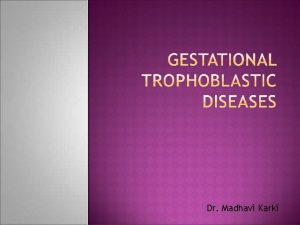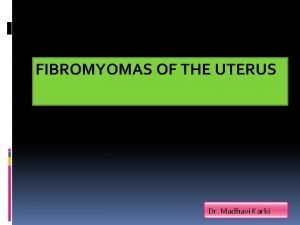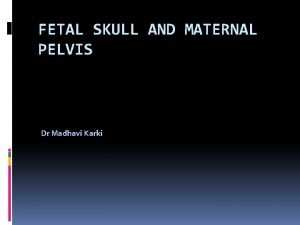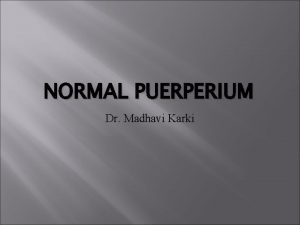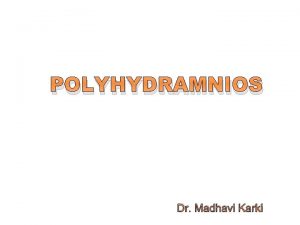CAESARIAN SECTION Dr Madhavi Karki DEFINITION The term





























- Slides: 29

CAESARIAN SECTION Dr. Madhavi Karki

DEFINITION : The term CAESARIAN SECTION denotes the delivery of a viable fetus, placenta and membranes through an incision in the abdominal wall and the uterine wall. The first caesarian section performed on a patient is known as PRIMARY CAESARIAN SECTION.

An elective is one which is performed before the onset of labour or before the occurrence of any complication which calls for an emergency intervention. EMERGENCY CS: PERFORMED IMMEDIATELY AFTER UNFORESEEN COMPLICATION DURING PREGNANCY OR LABOUR

INDICATIONS Pelvic Previous uterine contraction and surgery dystocia Hemorrhage maternal medical disorders Maternal obstetrics and Fetal indications health problems

Pelvic contraction and dystocia due to Cepahalo-pelvic disproportion Fetal malpresentation and malposition Incoordinate uterine action Non-progress of labour Soft tissue dystocia constriction ring, vaginal stenosis, cervical rigidity Neoplasms – fibroids , impacted ovarian cysts or non-pregnant horn of bicornuate uterus – obstructing labour Failed forceps and threatened uterine rupture

Previous uterine surgery Caesarian section Myomectomy Hysterotomy

HEMORRHAGE: Placenta praevia Abruptio placenta Vasa praevia Cancer cervix

MATERNAL MEDICAL DISORDERS: Severe hypertension Pre- eclampsia and eclampsia Renal disease diabetes mellitus Co- arctation of the aorta Herpes gestationalis Malignant disease, eg: leukemias, prior to chemotherapy

Maternal obstetrics and health problems Elderly primi gravida Prolonged previous infertility Previous repair of vagina – genital prolapse Bad obstetric history Previous difficult vaginal delivery Congenital uterine anomaly

FETAL INDICATIONS (i) Fetal distress (ii)Previous unexplained fetal death (iii)Umbilical cord prolapse (iv)Placental insufficiency (IUGR) (vii) Multiple Macrosomia (vi) Rh isopregnancy(tri (maternal immunization plets and diabetes, over) postmaturity)

Types of Operations: Lower Segment Caesarian Section: Classical Caesarian Section: Incision over the lower uterine segment. Incision is made in the upper uterine segment.

BEFORE CS: Informed Consent Inform Anesthetist, OR staff, Pediatrician 100% oxygen mask in case of fetal distress Transfer the patient to the OR, open IV line with wide bore cannula, take Blood for hemoglobin and blood grouping cross matching

PREOPERATIVE PREPARATION: The abdomen, back, private parts and upper parts of thighs are cleaned and shaved. Administration of 30 ml of 0. 3 molar sodium citrate orally half an hour before the surgery. Ranitidine: 150 mg is given orally night before and repeated 50 mg IV/IM one hour before surgery. Metoclopramide 10 mg IV Indwelling catheter FHS should be done more time at this stage

3 METHODS : EPIDURAL ANESTHESIA: SPINAL GENERAL

POSITION: The patient is placed in dorsal/ supine position. If spinal anesthesia has been given, a 15 degrees tilt to her left using sandbags till the delivery of the fetus is beneficial.

ANTISEPTIC PAINTING: Savlon Betadine Spirit The patient is then draped with sterile towel

: E R SKIN INCISIONS : Vertical: The incision extends from about 2. 5 cms below the umbilicus to the upper border of symphysis pubis. U D E C O PR ADVANTAGES: DISADVANTAGES: The scar is very apparent so cosmetically not very acceptable Simplicity There is more side-to-side tension on the scar Postoperative pain is considerable particularly on coughing or sneezing Easy to extend the incision Risk of wound dehiscence are higher and the incidence of incisional hernia Occurring at a later date is considerable. The delivery of the baby can be accomplished more quickly Since the midline is least vascular, healing maybe poor.

Pfannensteil (Transverse) Incision: The incision is semilunar and is made about two finger breadths above the symphysis pubis. ADVANTAGES : Post operative comfort is more DISADVANTAGES: Takes longer time Less chance of wound dehiscence Less chance of incisional hernia Cosmetic value Blood loss is more Requires more technical skill

PACKING : Apply Doyen’s retractor and push the bladder down. The peritoneal cavity is now packed using two large swabs. This will minimize Spilling of the uterine contents into the abdominal cavity.

Uterine Incision: Peritoneal Incision: Identify the lower uterine segment The loose peritoneum is picked with the help of dissecting forceps and incised transversely with the scissors.

(b) Muscle Incision: A small transverse incision is made in the midline. Extend with two index fingers.

Delivery of the Head: The membranes are ruptured if still intact. Suction of amniotic fluid and blood. The Doyen’s retractor is removed. The head is delivered by hooking the head with the fingers which are insinuated between the lower uterine flap and the head until the palm is placed below the head. Apply fundal pressure

Delivery of the Trunk: Suction of the mouth, pharynx and nostrils. Delivery of the shoulder. Administer 0. 2 mg methergin Deliver the rest of the baby Cord clamped and cut The Doyen’s retractor is reintroduced.

Removal of the Placenta and Membranes: - By controlled cord traction - Exploration of the uterine cavity

Suturing of the uterine wound: The uterine incision is sutured in three layers. 1. CONTINUOUS SUTURE : DEEP MUSCLES 3. PERITONEAL CLOSURE 2. CONTINUOUS SUTURE : SUPERFICIAL MUSCLES

Concluding Part: Mops placed inside are removed. Instrument and mop count performed. Peritoneum washed and clots removed Doyen’s Retractor removed Abdomen closed in layers. Vagina cleaned and vulval pad placed

POSTOPERATIVE CARE NPO TILL BOWEL SOUND RETURNS(24 hrs) IV FLUDS: AS PER REQUIREMENT IV ANTIBIOTICS PARENTRAL ANALGESICS VITALS CHARTING WATCH FOR PPH EARLY MOBILISATION SWITCH TO ORAL FEEDING AFTER BS+ STITCH REMOVAL ON 8 TH DAY

COMPLICATIONS OF CAESARIAN SECTION: MATERNAL : IMMEDIATE : • Hemorrhage and shock • Infections • Extension of incision and hematoma formation • Injury to the urinary bladder, ureter and bowel. • Paralytic ileus and peritonitis • Formation of pelvic abscess • Thromboembolism • Anesthetic complications: aspiration, hypotension • Incisional Hernia • Intestinal obstruction REMOTE: • Scar rupture in future pregnancy

FETAL COMPLICATIONS: Iatrogenic prematurity Respiratory distress syndrome Injury to the baby due to surgical knife Birth asphyxia due to anesthetic problems Birth injury due to difficult extraction
 Emma karki
Emma karki Madhavi ganapathiraju
Madhavi ganapathiraju Madhavi bhargava
Madhavi bhargava Madhavi deshmukh
Madhavi deshmukh Long medium and short term planning in primary schools
Long medium and short term planning in primary schools In my understanding
In my understanding Long term memory vs short term memory
Long term memory vs short term memory Quadratic sequences formula
Quadratic sequences formula Example of short term human resources
Example of short term human resources Position to term rule worksheet
Position to term rule worksheet Difference between long term and short term liabilities
Difference between long term and short term liabilities Accounting for serial bonds
Accounting for serial bonds Min term max term
Min term max term Rules in finding the nth term
Rules in finding the nth term Term to term rule
Term to term rule Short term goals examples for students
Short term goals examples for students Short term and long term cash forecasting
Short term and long term cash forecasting Hình ảnh bộ gõ cơ thể búng tay
Hình ảnh bộ gõ cơ thể búng tay Frameset trong html5
Frameset trong html5 Bổ thể
Bổ thể Tỉ lệ cơ thể trẻ em
Tỉ lệ cơ thể trẻ em Chó sói
Chó sói Chụp phim tư thế worms-breton
Chụp phim tư thế worms-breton Hát lên người ơi alleluia
Hát lên người ơi alleluia Các môn thể thao bắt đầu bằng từ đua
Các môn thể thao bắt đầu bằng từ đua Thế nào là hệ số cao nhất
Thế nào là hệ số cao nhất Các châu lục và đại dương trên thế giới
Các châu lục và đại dương trên thế giới Công thức tiính động năng
Công thức tiính động năng Trời xanh đây là của chúng ta thể thơ
Trời xanh đây là của chúng ta thể thơ Mật thư tọa độ 5x5
Mật thư tọa độ 5x5






























